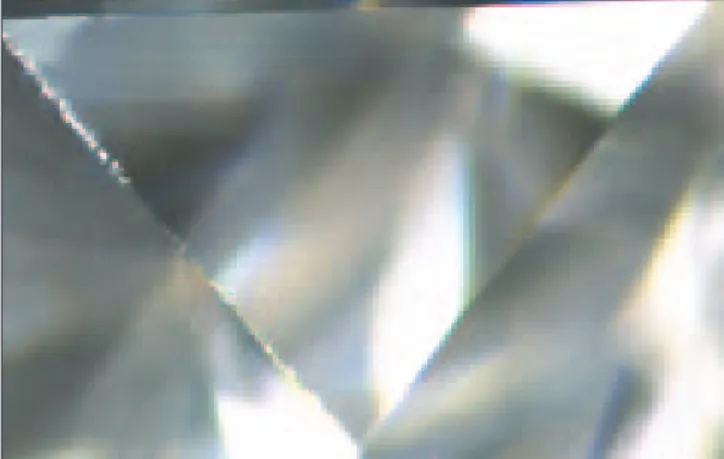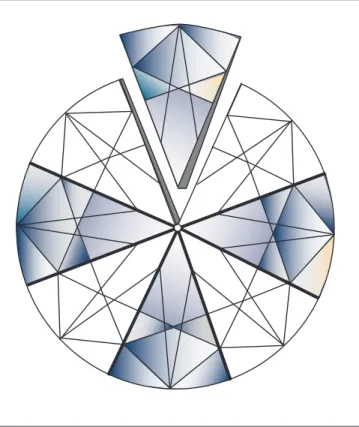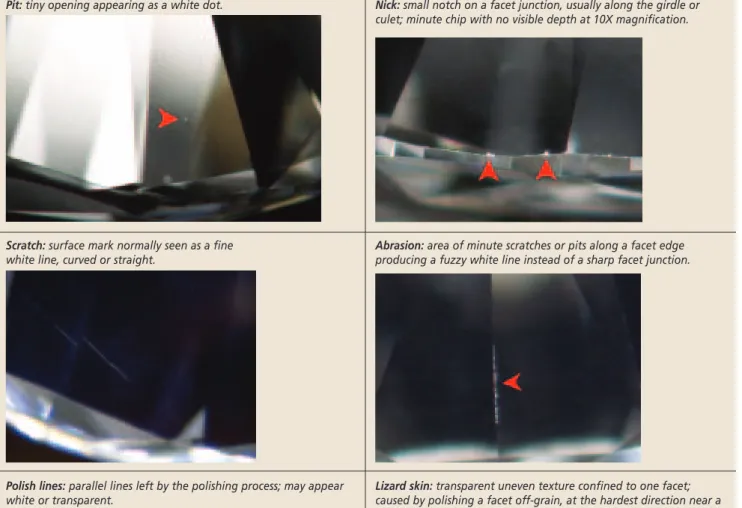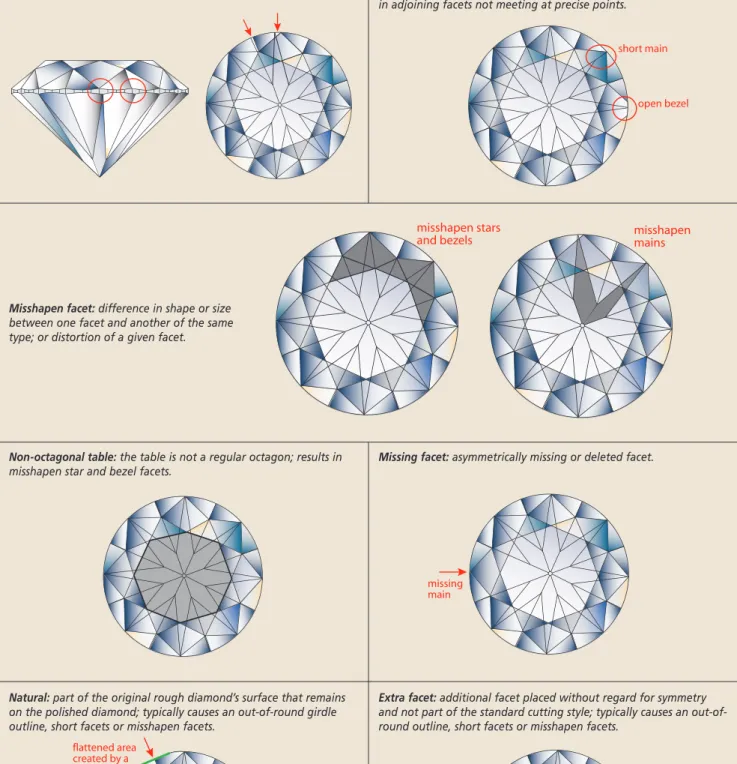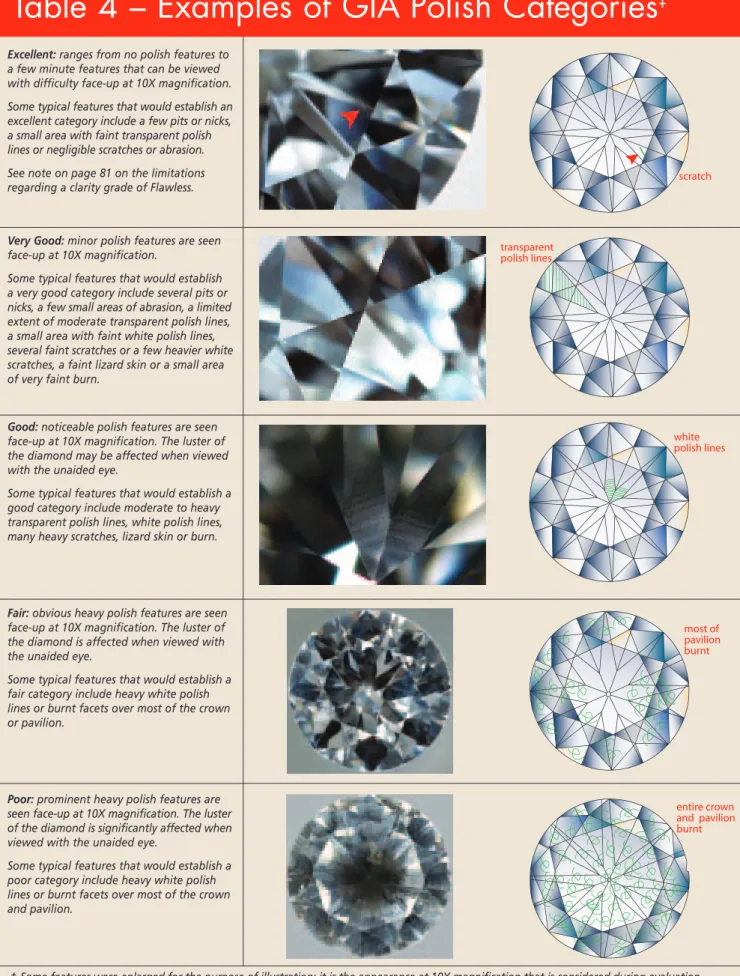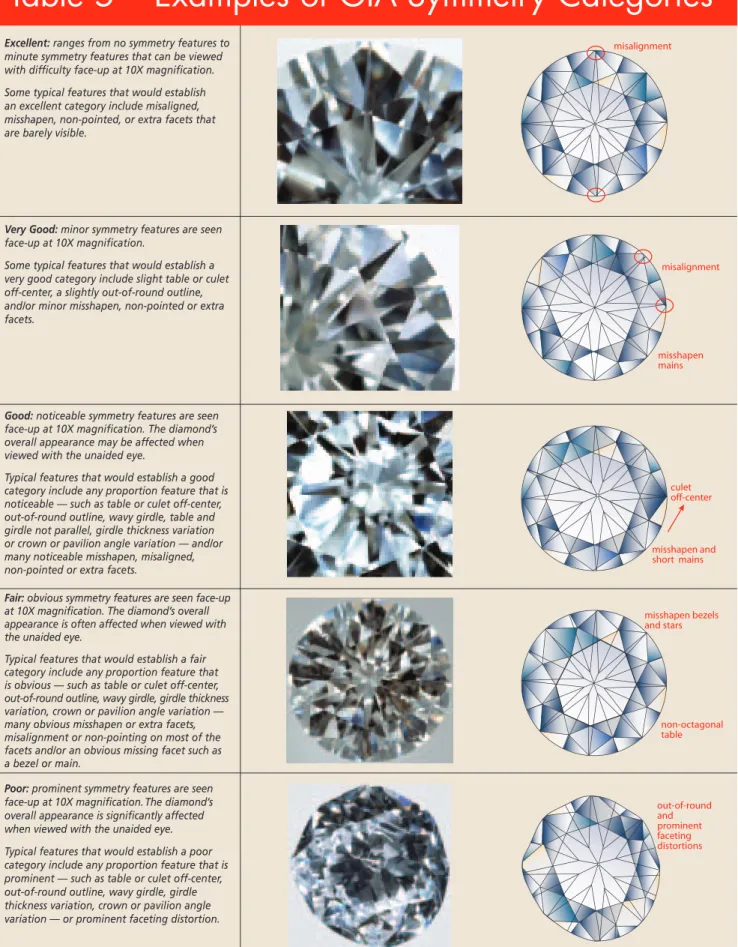n the new Gemological Institute of America (GIA) Diamond Cut Grading System for standard round bril-liant diamonds, the aspect of craftsmanship — i.e., the care that went into the crafting of a polished diamond, as seen in its finish — plays an important role in the over-all cut grade along with the other aspects of face-up appear-ance and design (see figure 1).The two categories that define finish — polish and symmetry — have been part of GIA’s International Diamond Grading System™ since its incep-tion in the mid-1950s and are listed on each GIA Diamond Grading Report and Diamond Dossier®. It is important to note that with the introduction of the new cut grading system, the criteria for determining polish and symmetry remain the same.The following is a review of the criteria and the methods used for assessing them, and will explain their role in the new cut grading system.This article expands on the GIA’s course material for assessing polish and sym-metry, describes the guidelines used by the GIA Labora-tory in evaluating finish and presents specific examples of the different polish and symmetry categories.
In the GIA Diamond Grading System,“polish”refers to the quality of a diamond’s surface condition as a result of the polishing process (see figure 2) or to blemishes created after the cutting process, often referred to as “wear and tear” (see figure 3). Polish features are located on the sur-face and do not visibly penetrate into the diamond at 10X magnification. Polish is assessed on a scale consisting of excellent, very good, good, fair and poor. “Symmetry” refers to the exactness of the shape of a diamond, and the
symmetrical arrangement and even placement of the facets (see figure 4). Symmetry is also assessed on a scale ranging from excellent to poor.
In the GIA Diamond Cut Grading System for standard round brilliant diamonds, on the GIA D-to-Z color scale and Flawless-to-I3 clarity scale, finish is factored into the final overall cut grade as follows:
• To qualify for an excellent cut grade, both polish and symmetry must be very good or excellent.
• To qualify for a very good cut grade, both polish and symmetry must be at least good.
BYDANIELB. GILLEN, BRUCE F. LANZL ANDPHILLIPM. YANTZER G E M O L O G Y
Polish and Symmetry
I
Craftsmanship in the GIA Diamond Cut Grading System:
Evaluating Finish in Standard Round Brilliant Diamonds
Figure 1. Craftsmanship is one of the three core aspects of the GIA Diamond Cut Grading System.
• To qualify for a good cut grade, both polish and sym-metry must be at least fair.
• To qualify for a fair cut grade, both polish and symme-try must be at least fair.
• A poor cut grade is assigned when either polish or symmetry is poor.
To determine the relationship between finish and over-all cut quality, GIA conducted extensive observation test-ing ustest-ing standardized lighttest-ing and viewtest-ing conditions. Observations of diamonds with comparable proportions, but differing in their polish and symmetry categories,were analyzed to determine the effects of finish on overall cut appearance. In this way, GIA researchers found that a one grade difference between the other aspects of a diamond’s cut grade and its polish and symmetry assessments did not significantly lower a trained observer’s assessment of face-up appearance, and could not be discerned reliably with the unaided eye — e.g., polish and/or symmetry descrip-tions of very good did not cause observers to lower their assessment of a diamond that would otherwise receive an overall cut grade of excellent.
POLISH
A number of features are considered in the evaluation of polish. Examples and definitions of these are provided in table 1, Polish Features, on page 83.
Diamond graders consider the amount and visibility of the polish features present.The general appearances of GIA’s five polish categories are described here.
Excellent:ranges from no polish features to a few minute polish features that can be viewed with diffi-culty face-up at 10X magnification.*
Very Good:minor polish features are seen face-up at 10X magnification.
Good:noticeable polish features are seen face-up at 10X magnification.The luster of the diamond may be affected when viewed with the unaided eye.
Fair:obvious heavy polish features are seen face-up at 10X magnification.The luster of the diamond is affected when viewed with the unaided eye.
Poor:prominent heavy polish features are seen face-up at 10X magnification.The luster of the diamond is significantly affected when viewed with the unaided eye.
As with all other aspects of diamond grading, standard methodology and a controlled environment are used to evaluate polish consistently, with the final determination based on an objective consensus of independent grader opinions.The following steps are performed at 10X mag-nification with either a fully corrected loupe or gemolog-ical microscope under darkfield illumination to assess the polish:
• The diamond is first examined face-up, girdle-to-gir-dle to gain an initial impression of the polish.
• The diamond is then examined one section at a time, through both the crown and pavilion, to locate and identify the specific polish features present.
• The diamond is again examined face-up,girdle-to-girdle, and this time viewed in at least four different positions with a loupe; some features may be more or less apparent depending on the orientation of the diamond.
• A visual polish description is assigned that considers the diamond’s overall face-up appearance as well as polish features seen in any view. Emphasis is placed on the diamond’s face-up appearance with a 10X loupe.
SYMMETRY
As with polish,a number of features are considered in the evaluation of symmetry; these are defined and illustrated in tables 2 and 3 on pages 84-85. Symmetry features can be subdivided into two categories:proportion related (see table 2,Proportion-Related Symmetry Features) and facet related
Figure 2. The white lines seen across this lower half facet result from the polishing process. This and all following photomicrographs were taken
using a standard gemological microscope in darkfield illumination. Figure 3. Abrasion caused by wear is seen here along a star facet.
*Although a diamond with a few minute polish features might qualify for the excellent polish category, the same diamond could not qualify for a Flawless clarity grade. Only diamonds with no polish features visible at 10X magnification qualify for a Flawless clarity grade.
(see table 3, Facet-Related Symmetry Features). Due to a polished diamond’s three-dimensional nature,the presence of one symmetry feature may result in others.Graders con-sider the extent and visual appearance of any symmetry fea-tures present.The general appearances of GIA’s five symmetry categories are described here.
Excellent:ranges from no symmetry features to minute symmetry features that can be viewed with difficulty face-up at 10X magnification.
Very Good:minor symmetry features are seen face-up at 10X magnification.
Good:noticeable symmetry features are seen face-up at 10X magnification.The diamond’s overall appearance may be affected when viewed with the unaided eye.
Fair:obvious symmetry features are seen face-up at 10X magnification.The diamond’s overall appearance is often affected when viewed with the unaided eye.
Poor:prominent symmetry features are seen face-up at 10X magnification.The diamond’s overall appear-ance is significantly affected when viewed with the unaided eye.
The following steps are performed at 10X magnification with either a fully corrected loupe or gemological micro-scope under darkfield illumination to determine the sym-metry of a polished diamond. Again, the final result is an objective consensus of independent grader opinions. • The diamond is first examined face-up, girdle-to-girdle
in order to gain an initial impression of the symmetry. • The diamond is then rotated in profile view to reveal
any symmetry features that are best seen in this position — such as non-pointing, misalignment, wavy girdle, girdle thickness variation, table and girdle not parallel, crown angle variation and pavilion angle variation. • The diamond is again examined face-up,girdle-to-girdle,
and this time viewed in at least four different positions with a loupe;some features may be more or less apparent depending on the orientation of the diamond.
• A visual symmetry description is assigned that considers the diamond’s face-up appearance as well as symmetry features seen in profile view. Emphasis is placed on the diamond’s face-up appearance with a 10X loupe. Table 4,Examples of GIA Polish Categories,page 86,and table 5, Examples of GIA Symmetry Categories, page 87, provide examples and typical grade-setting characteristics for each polish and symmetry category using the established methods of the GIA Laboratory.
CONCLUSION
The aspect of craftsmanship has always been part of GIA’s International Diamond Grading System as it is practiced in the GIA Laboratory and taught in GIA’s educational
courses. Beginning January 1, 2006, each GIA Diamond Grading Report and Diamond Dossier for a round bril-liant diamond also will include a cut grade. Craftsmanship — which is assessed through the evaluation of polish and symmetry under controlled conditions with consistent methodology — will be an important aspect in the deter-mination of a diamond’s overall cut quality.
The series of articles presented in the Rapaport Diamond
Reportover the past few months has been offered to help
diamond dealers, manufacturers and retailers alike under-stand the factors involved in GIA’s cut grading as well as the methods used by the GIA Laboratory in the overall grad-ing process.Additional information on the GIA Diamond Cut Grading System can be found on GIA’s website — www.diamondcut.gia.edu — and related articles can be found in past issues of Gems & Gemology(Fall 1998,Fall 2001 and Fall 2004).
Note:While this article focuses on the evaluation of polish and symmetry for the standard round brilliant cut, most of the criteria apply similarly to fancy shapes with the addition of some specific guidelines in regard to shape and lines of symmetry.An article that specifically addresses the evaluation of symmetry for fancy shapes is planned for future publication.All images © 2005 GIA. Pho-tomicrographs by Mitchell Moore, Robert Spencer, Derek Sharpe, Yuen Chan and Vincent Cracco.
Figure 4. Round shapes should be symmetrical through a 360-degree rotation; that is, each of the sections of the round shape should match. In a standard round brilliant diamond, there are eight sections that should match, and a section typically consists of a bezel-main intersection and two upper and lower halves.
Pit:tiny opening appearing as a white dot. Nick:small notch on a facet junction, usually along the girdle or culet; minute chip with no visible depth at 10X magnification.
Scratch:surface mark normally seen as a fine
white line, curved or straight.
Abrasion:area of minute scratches or pits along a facet edge
producing a fuzzy white line instead of a sharp facet junction.
Polish lines:parallel lines left by the polishing process; may appear
white or transparent.
Lizard skin:transparent uneven texture confined to one facet;
caused by polishing a facet off-grain, at the hardest direction near a cleavage plane.
Burn mark or burned facet:whitish haze across a facet or
on a concentrated area caused by excessive heat during polishing or occasionally by a jeweler’s torch.
Rough girdle:irregular pitted or granular surface of a bruted girdle
due to pits and nicks.
Table 2 – Proportion-Related Symmetry Features
Note that variations in crown height and/or pavilion depth result from one or more of the following deviations: wavy girdle, table and girdle not parallel, crown angle variation, pavilion angle variation and/or girdle thickness variation.
flattened area
Out-of-round:deviation from the circular shape of a round diamond;
a flattened area such as that created by a natural or extra facet also constitutes out-of-round. Comparison of the minimum and maximum diameters can help assess roundness.
table off-center
Table off-center:deviation of the table from the central position on
the crown; results in opposing bezels of differing sizes. When viewed through the table, more of the pavilion is seen to one side of the culet than the other.
culet off-center
Culet off-center:deviation of the culet from the central position
on the pavilion; results in the cross-line formed by lower half facet junctions to be bowed or bent. When viewed through the table, more of the pavilion is seen to one side of the culet than the other.
Table/culet alignment:displacement of the table facet and culet in
opposite directions.
Table and girdle not parallel:the girdle plane is not parallel to the table.
Wavy girdle:undulating girdle. Girdle thickness variation:variation of the girdle thickness at “valley”
positions.
Crown angle variation:all eight crown angles are not equal; typically
related to table off-center.
Pavilion angle variation:all eight pavilion angles are not equal;
Misalignment:displacement of the crown and pavilion facets in relation to each other.
open bezel short main
Non-pointing:fully formed facet that does not reach its prescribed
location (short facet) or is incompletely finished (open facet), resulting in adjoining facets not meeting at precise points.
misshapen stars
and bezels misshapen mains
Misshapen facet:difference in shape or size
between one facet and another of the same type; or distortion of a given facet.
Non-octagonal table:the table is not a regular octagon; results in
misshapen star and bezel facets.
missing main
Missing facet:asymmetrically missing or deleted facet.
flattened area created by a natural
Natural:part of the original rough diamond’s surface that remains
on the polished diamond; typically causes an out-of-round girdle outline, short facets or misshapen facets.
extra facet on pavilion
Extra facet:additional facet placed without regard for symmetry
and not part of the standard cutting style; typically causes an out-of-round outline, short facets or misshapen facets.
Table 4 – Examples of GIA Polish Categories
‡‡ Some features were enlarged for the purpose of illustration; it is the appearance at 10X magnification that is considered during evaluation. Note, too, that each finish category encompasses a range of appearances and the selected examples do not represent the highest or lowest point of that category.
scratch
Excellent:ranges from no polish features to
a few minute features that can be viewed with difficulty face-up at 10X magnification. Some typical features that would establish an excellent category include a few pits or nicks, a small area with faint transparent polish lines or negligible scratches or abrasion. See note on page 81 on the limitations regarding a clarity grade of Flawless.
transparent polish lines
Very Good:minor polish features are seen
face-up at 10X magnification.
Some typical features that would establish a very good category include several pits or nicks, a few small areas of abrasion, a limited extent of moderate transparent polish lines, a small area with faint white polish lines, several faint scratches or a few heavier white scratches, a faint lizard skin or a small area of very faint burn.
white polish lines
Good:noticeable polish features are seen
face-up at 10X magnification. The luster of the diamond may be affected when viewed with the unaided eye.
Some typical features that would establish a good category include moderate to heavy transparent polish lines, white polish lines, many heavy scratches, lizard skin or burn.
most of pavilion burnt
Fair:obvious heavy polish features are seen
face-up at 10X magnification. The luster of the diamond is affected when viewed with the unaided eye.
Some typical features that would establish a fair category include heavy white polish lines or burnt facets over most of the crown or pavilion.
entire crown and pavilion burnt
Poor:prominent heavy polish features are
seen face-up at 10X magnification. The luster of the diamond is significantly affected when viewed with the unaided eye.
Some typical features that would establish a poor category include heavy white polish lines or burnt facets over most of the crown and pavilion.
Table 5 – Examples of GIA Symmetry Categories
‡‡ Some features were enlarged for the purpose of illustration; it is the appearance at 10X magnification that is considered during evaluation. Note, too, that each finish category encompasses a range of appearances and the selected examples do not represent the highest or lowest point of that category.
misalignment
Excellent:ranges from no symmetry features to minute symmetry features that can be viewed with difficulty face-up at 10X magnification. Some typical features that would establish an excellent category include misaligned, misshapen, non-pointed, or extra facets that are barely visible.
misshapen mains
misalignment
Very Good:minor symmetry features are seen face-up at 10X magnification.
Some typical features that would establish a very good category include slight table or culet off-center, a slightly out-of-round outline, and/or minor misshapen, non-pointed or extra facets.
culet off-center misshapen and short mains
Good:noticeable symmetry features are seen face-up at 10X magnification. The diamond’s overall appearance may be affected when viewed with the unaided eye.
Typical features that would establish a good category include any proportion feature that is noticeable — such as table or culet off-center, out-of-round outline, wavy girdle, table and girdle not parallel, girdle thickness variation or crown or pavilion angle variation — and/or many noticeable misshapen, misaligned, non-pointed or extra facets.
non-octagonal table misshapen bezels and stars
Fair: obvious symmetry features are seen face-up at 10X magnification. The diamond’s overall appearance is often affected when viewed with the unaided eye.
Typical features that would establish a fair category include any proportion feature that is obvious — such as table or culet off-center, out-of-round outline, wavy girdle, girdle thickness variation, crown or pavilion angle variation — many obvious misshapen or extra facets, misalignment or non-pointing on most of the facets and/or an obvious missing facet such as a bezel or main. out-of-round and prominent faceting distortions
Poor:prominent symmetry features are seen face-up at 10X magnification. The diamond’s overall appearance is significantly affected when viewed with the unaided eye. Typical features that would establish a poor category include any proportion feature that is prominent — such as table or culet off-center, out-of-round outline, wavy girdle, girdle thickness variation, crown or pavilion angle variation — or prominent faceting distortion.

